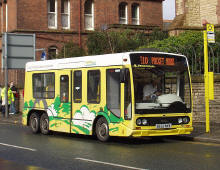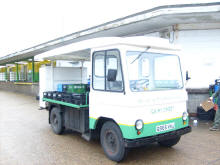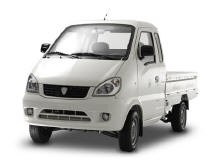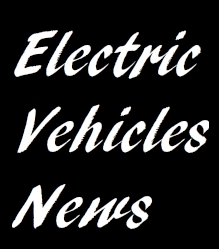|
A battery electric vehicle, or BEV, is a type of
electric vehicle (EV) that uses chemical energy
stored in
rechargeable battery
packs.
As with other
electric vehicles, BEVs use
electric motors and
motor controllers instead of
internal combustion engines (ICEs) for propulsion.
All-electric and hybrid electric vehicles
Vehicles using both electric motors and internal combustion engines
are examples of
hybrid electric vehicles, and are not considered pure (or all) EVs
because they operate in a
charge-sustaining mode.
- Regular hybrid electric vehicles cannot be externally charged.
- Hybrid vehicles with batteries that can be charged externally to
displace some or all of their internal combustion engine power and
gasoline fuel are called
plug-in hybrid electric vehicles (PHEV), and are BEVs during their
charge-depleting mode.
All-electric and plug-in hybrids are off-vehicle charge capable (“OVCC”
or pluginable), which means their
batteries can be charged from an off-vehicle electric energy source
that cannot be connected or coupled to the vehicle while the vehicle is
being driven.
Vehicles
The concept of battery electric vehicles is to charge
batteries on board vehicles for propulsion using the
electric grid.
The main advantages of battery electric vehicles are that:
- No pollutants are emitted directly by the vehicle potentially
reducing urban pollution. This does not take into account additional
pollutants that are emitted if any fossil fuel power plant is used to
create the electricity, though a centralized pollution source can be
dealt with more easily.
- Gasoline is indirectly replaced by whatever is being used to
generate domestic electricity, reducing dependence on foreign
commodities. The
electrical energy stored within the battery can be generated by
any source, including renewable, nuclear, natural gas, coal and
petroleum.
Battery electric cars are becoming more and more attractive with the
advancement of new battery technology (Lithium
Ion) that have higher power and
energy density (i.e. greater possible acceleration and more range
with less batteries) and higher oil prices.
Electric bus

A battery-electric minibus in St Helens, England
Chattanooga, Tennessee operates nine
zero-fare electric buses, which have been in operation since 1992
and have carried 11.3 million passengers and covered a distance of
3,100,000 kilometres (1,930,000 mi), They were made locally by Advanced
Vehicle Systems. Two of these buses were used for the 1996 Atlanta
Olympics.
Wrightbus has a new a hybrid-electric driveline for the StreetCar
RTV which has been developed in conjunction with the ISE Corporation of
California and incorporates Siemens ELFA traction components and a
Cummins ISL engine. The chassis is built to Wright Group specifications
by Swiss trolleybus specialists Carosserie Hess and is powered by
Valence Technology lithium phosphate batteries .
Beginning in the summer of 2000, Hong Kong airport began operating a
16-passenger Mitsubishi Rosa electric shuttle bus, and in the fall of
2000, New York City began testing a 66-passenger battery-powered school
bus, an all electric version of the Blue-Bird TC2000.
A similar bus was operated in
Napa Valley, California for 14 months ending in April, 2004.
The
2008 Beijing Olympics used a fleet of 50 electric buses, which have
a range of 130 km (81 mi) with the air conditioning on. They use
Lithium-ion batteries, and consume about 1 kW·h/mi (0.62 kW·h/km; 2.2 MJ/km).
The buses were designed by the Beijing Institute of Technology and built
by the Jinghua Coach Co. Ltd.
The batteries are replaced with fully charged ones at the recharging
station to allow 24 hour operation of the buses.
Thunder Sky
Thunder Sky Energy Group of
Shenzhen, China (near Hong Kong) builds
lithium-ion batteries used in submarines and has four models of
electric buses, the ten passenger EV-6700 with a range of 260 km
(160 mi), the TS-6100EV and TS-6110EV city buses, and the 43 passenger
EV-2008 highway bus, which has a range of 300 km (190 mi). The batteries
can be recharged in 1 hour or replaced in 5 minutes. The buses are also
to be built in the United States and Finland.
Valence
Valence Technology has entered into a contract with The Tanfield Group
Plc. to manufacture and supply Lithium Phosphate energy
storage systems to power Tanfield’s all-electric commercial delivery
vehicles. The Valence battery systems will be installed in vans and
trucks produced by Tanfield’s UK-based trading division, Smith Electric
Vehicles, the world’s largest manufacturer of electric vans and trucks.
Free Tindo
Tindo is an all-electric bus from
Adelaide, Australia. The Tindo (aboriginal word for sun) is made by
Designline International
in
New Zealand and gets its electricity from a
solar PV system on Adelaide's central
bus station. Rides are
zero-fare as part of Adelaide's public transport system.
Semi tractor-
trailer
The Port of Los Angeles and South Coast Air Quality Management
District have demonstrated a short-range heavy-duty all electric truck
capable of hauling a fully loaded 40-foot (12 m) cargo container. The
current design is capable of pulling a 60,000 lb (27 t) cargo container
at speeds up to 40 mph (64 km/h) and has a range of between 30 and 60
miles (48 and 97 km). It uses 2 kilowatt-hours per mile (1.2 kW·h/km;
4.5 MJ/km), compared to 5 miles per US gallon (47 L/100 km; 6.0 mpg-imp)
for the
hostler
semi tractors it replaces.
Milk float

A Dairy Crest Smith's Elizabethan milk float
A common example of the battery electric vehicle is the
milk float. Since it makes many stops in delivering milk it is more
practical to use an electric vehicle than an ICE, which would be idling
much of the time; it also reduced noise in residential areas. For most
of the 20th century, the majority of the world's battery electric road
vehicles were British milk floats.
Garbage truck
With a similar driving pattern of a delivery vehicle like the milk
float above, garbage trucks are excellent candidates for electric drive.
Most of their time is spent stopping, starting or idling. These
activities are where
internal combustion engines are their least efficient. In
preparation for the 2008 Olympic Games, 3,000 of the internal combustion
engine garbage trucks in Beijing
were replaced with
lithium ion polymer battery pack electric drive trucks.
The batteries were procured for about $3,300 each.
Pickup trucks

ZX40ST Electric Truck
One of the surviving
electric vehicles from the late 1990s is the
Chevy S-10 electric pickup truck. Many other vehicles from this era,
such as the
General Motors EV1 were recalled and destroyed. A newcomer is the
Miles Electric Vehicles ZX40ST electric truck now available in the
United States.
Miles Electric Vehicles is based in
Santa Monica, California.
The Big Bike Company Limited, in Gloucestershire, England, is
now offering fully electric pick up trucks for sale. Powered by an
impressive bank of batteries, these small utility vehicles are able to
deliver a payload of approximately 500kgs, and have a range of up to 80
miles. Using a 3 wheel configuration, the rolling and aerodynamic drag
is reduced. As a tricycle it can also be driven on a motorcycle license.
They are marketed on the internet, and can be viewed on a temporary web
site at www.electrux.net.
Motors
Motor controllers
The motor controller regulates the power to the motor, supplying
either variable pulse width DC or variable frequency variable amplitude
AC, depending on the motor type, DC or AC.
Electric cars have traditionally used series wound DC motors, a form
of
brushed DC electric motor. More recent electric vehicles have made
use of a variety of AC
motor types, as these are simpler to build and have no brushes that
can wear out. These are usually
induction motors or
brushless AC electric motors which use permanent magnets. There are
several variations of the permanent magnet motor which offer simpler
drive schemes and/or lower cost including the
brushless DC electric motor.
Fuel use in vehicle designs
| Vehicle type |
Fuel used |
|
All-petroleum vehicle |
Most use of petroleum |
|
Regular hybrid electric vehicle |
Less use of petroleum, but non-pluginable |
|
Plug-in hybrid vehicle |
Residual use of petroleum. More use of electricity |
| All-electric vehicle |
Most use of electricity |
|



